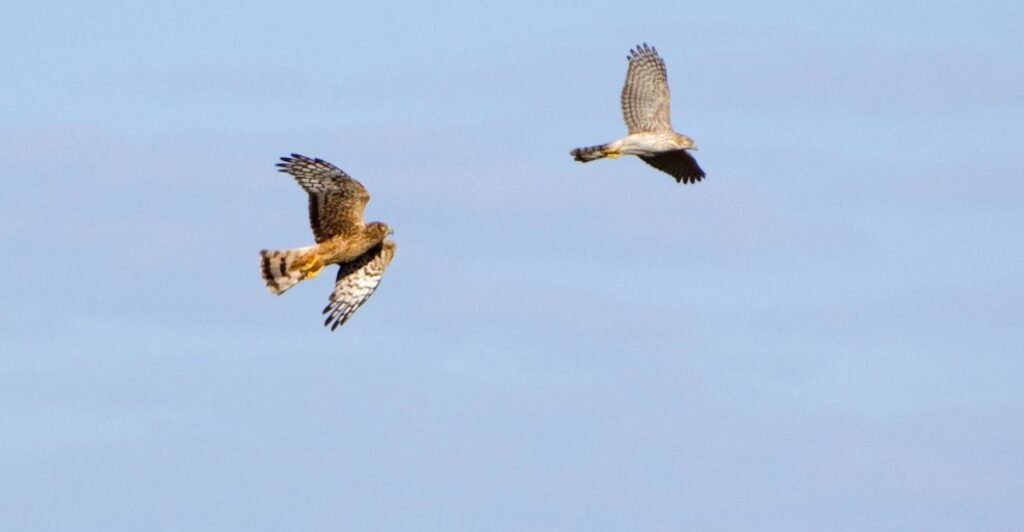
Spotting a raptor in the wild is thrilling, but how do you know if it’s a falcon or a hawk? That’s where the fun begins. These birds of prey are packed with distinct traits, from their hunting grounds to their calls. Discover what sets them apart and sharpen your birdwatching skills.
1. Preferred Hunting Grounds Define Their Strategy

Picture a hawk perched on a low branch, eyes locked on a field mouse scuttling below. Hawks excel in forests and fields, where cover helps them ambush prey. However, falcons own the open skies, using cliffs and high perches to launch lightning-fast aerial pursuits.
2. Speed Records Break in the Sky

Falcons are nature’s speed demons. The peregrine falcon holds the title for the fastest animal on Earth, which dives at speeds over 240 mph! Though no slouches, Hawks prefer efficiency over speed and use glides and soaring techniques to save energy during long hunts.
3. Calls and Sounds Tell You Who’s Talking

Close your eyes and listen. Especially near their nests, falcons prefer fast, high-pitched chatter. Hawks announce themselves with sharp, drawn-out screeches that echo through forests. It’s like one bird’s yelling orders while the other’s sounding an alarm.
4. Talons Are Customized for the Hunt

Ever wonder why the Hawks grip like a vise? Their thick, curved talons are designed for crushing small mammals. Notably, falcons take a different approach—slender, needle-sharp talons that pierce the spine of birds they catch mid-flight. Each bird has the right tool for the job.
5. Migration Routes Reveal Their Routines

Migration season tells you a lot about these raptors. Hawks follow predictable routes along mountain ridges and coastlines, catching warm updrafts. On the other hand, falcons are risk-takers and fly straight over open water to get to their destination faster.
6. Parenting Styles Show Who Stays and Who Sprints

Hawk parents stick around for months and teach their chicks how to hunt and survive. When it comes to falcons, in addition to giving them a fast-track survival course before being sent off on their own, they push their young toward independence quickly.
7. Flight Patterns Make Identification Easy

Look to the sky and play detective. Hawks glide in slow, wide circles, wings outstretched like a kite. Falcons fly with quick, snappy wingbeats, followed by sharp, direct glides. Once you learn the difference, you’ll never confuse them again.
8. Territory Defense Tactics Show Their Personalities

Some raptors are homebodies; others are hotheads. It doesn’t take the falcon long to go from zero to aggressive if something gets too close to its nest. On the other hand, Hawks patrol large territories that drive away intruders with loud calls and aerial chases.
9. Breeding Habits Separate Their Strategies

Nest construction says a lot about a bird. For hawks, they spend days building sturdy stick nests in tall trees, often using the same one for years. Falcons? They take the easy route, claiming cliffs, ledges, or even abandoned buildings.
10. Plumage Patterns Offer Visual Clues

Want a quick ID trick? Check the chest. Falcons rock horizontal barring, like tiny feathered zebras. Meanwhile, the Hawks sport vertical streaks that make them look like they’re wearing pinstripes. These patterns aren’t just stylish—they help with camouflage during the hunt.
11. Diet Diversity Reflects Their Skills

Dinner time looks different for each bird. While hawks love ground dwellers like rabbits, squirrels, and snakes, falcons are all about high-speed chases, snatching pigeons, ducks, or smaller songbirds right out of the air. Their menus are as different as their hunting styles.
12. Reactions to Humans Highlight Their Adaptability

Some raptors don’t mind city life. Falcons have adapted beautifully, nesting on skyscrapers and hunting pigeons in busy streets. Hawks prefer a quieter life, steering clear of human chaos. They’re like neighbors who either throw wild parties or avoid the block altogether.
Stay connected with us for more stories like this! Follow us to get the latest updates or hit the Follow button at the top of this article, and let us know what you think by leaving your feedback below. We’d love to hear from you!







